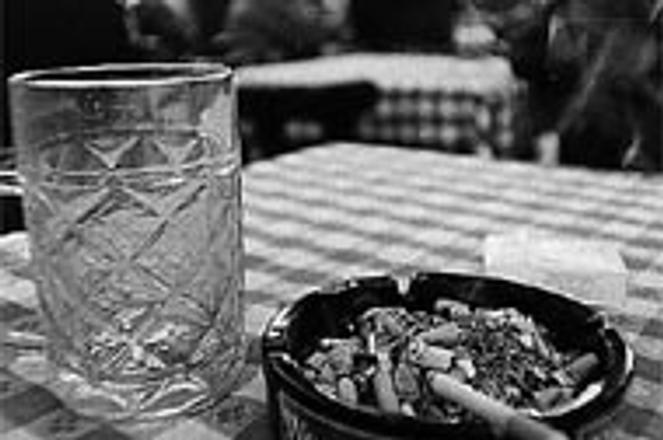Restaurants have until July 1 to divide their premises fifty-fifty between smoking and non-smoking areas.Vladimír Hák
Come July 1, people who want to have a smoke while waiting for their train can forget it, unless they're willing to pay a fine worth a carton of cigarettes.
Beginning this summer, Slovaks will have what some praise as a progressive law defending non-smokers, but what others view as "a smoking big brother" infringing upon their rights to take a puff.
In February, parliament passed a No-Smokers' Protection Law submitted by 55 deputies from both the coalition and the opposition. "This time, parliament did not split into political camps, but into camps of smokers and non-smokers," said Roman Kováč, a former heavy smoker who co-sponsored the bill. "This is the only example in this term where the opposition and the coalition managed to unite to accomplish a good thing."
Slovaks' life expectancy, averages 66 years, ranking it near the bottom in Europe. Cardiovascular and oncological diseases are most responsible for the ranking; in fact, cancer kills one out of every five Slovaks.
The law forbids smoking in indoor public places as well as on covered platforms and public transportation stops. Smoking is allowed only at designated places in public buildings, i.e. government offices, health care institutions, cinemas and other cultural institutions, schools, shops and sports arenas.
The law also hits the source, mandating that tobacco producers gradually reduce the tar content in cigarettes. After December 1, 1998, a cigarette can contain no more than 15 mg of tar, and beginning January 1, 2001, it has to squeeze that under 12 mg, the same amount now in a "light" cigarette. Even then, though, Slovakia will lag behind a similar EU regulation that comes into effect on January 1, 1998.
The law also concerns owners of any establishment that serves food, demanding that at least 50 percent of capacity is reserved for non-smokers. If this is not possible, no smoking is allowed during breakfast, lunch or dinner hours. The no-smoking section also has to be properly ventilated.
Depending on the seriousness of the offense, a private person can pay up to 500 Sk, small entrepreneurs from 500 to 100,000 Sk and producers and wholesale distributors from 50,000 to 5 million Sk.
Youth target
According to Kováč, the law aims to remove massive advertising directed at youth and to introduce a public awareness campaign based on the slogan: "It's cool not to smoke." Kováč believes that cigarette consumption can be reduced in two ways - by radically limiting advertising and upping tobacco products' prices. He noted that 11 EU countries want a complete ban on tobacco products' advertising.
"In the USA, they spent a ton of money to fight smoking," Kováč said, "not looking at a four-year election term, but with a horizon spanning decades to protect citizens' health." Every year, Slovakia incurs health losses amounting to 32.5 billion Sk, while annual revenues from a cigarette consumption tax is only 2.8 billion Sk, according to statistics Kováč obtained from the Finance Ministry.
According to Kováč, analyses conducted abroad show that efforts now to limit smoking will yield results in the population's health in 30 years. Determined not to lose a single day, the law's sponsors are working with the media, doctors and NGO's in June to inform people about the legislation before it takes effect on July 1. The tobacco lobby is not impressed with the quick mobilization.
"The most severe blow which gives us headaches are the restrictions in the so-called tobacco advertising, i.e. in presentating our products," said Jozef Banáš, the public relations director for the Slovak International Tabak (S.I.T.) joint stock company.
According to Banáš, the Slovak law puts lesser-known brands at a disadvantage.
"The problem is that after Czechoslovakia split, the Czechoslovak...cigarette brands were divided as well. While the Czechs kept the well-known brands that don't need any advertising, such as Marlboro, Sparta, Petra, Štart and LM, Slovaks were left with working-class brands like Mars and Dalila. Therefore S.I.T. had to introduce some decent brands, such as West, Astor, R1, and recently the most luxurious cigarettes Davidoff. We need at least a chance to explain to customers what these products are like," Banáš said.
There's also the money tobacco brings in, Banáš added.
"Our contribution to the state budget was 1.4 billion Sk [in excise taxes] plus 162 million Sk [in corporate taxes]," Banáš said. "My question is why doesn't the state use this money for information campaigns or sports activities."


